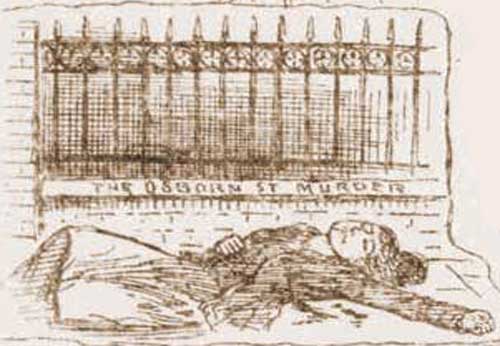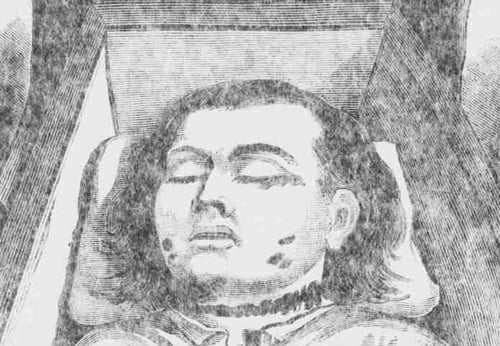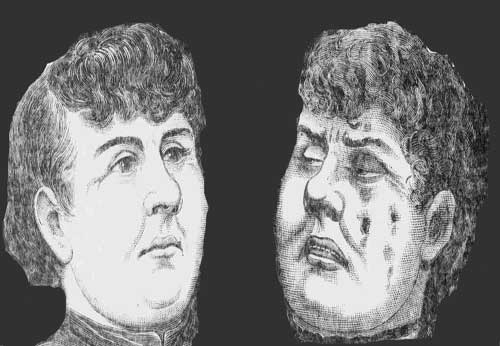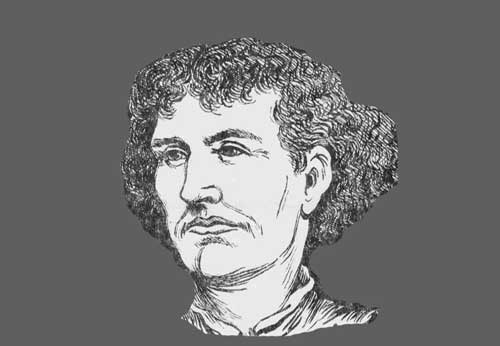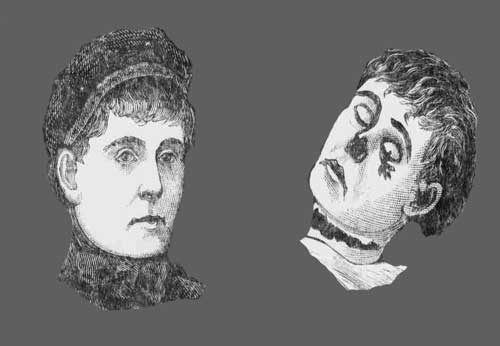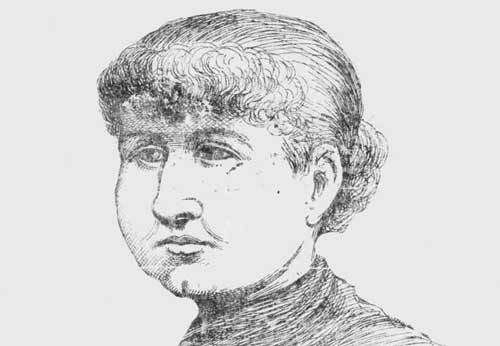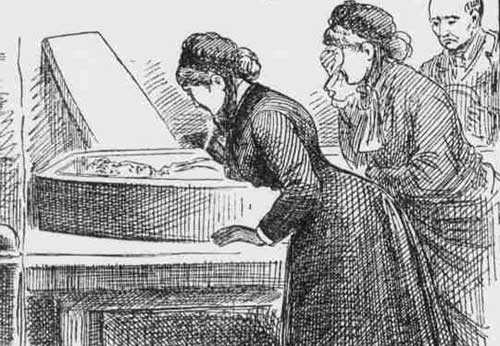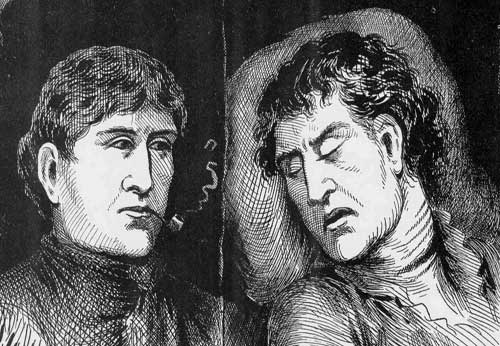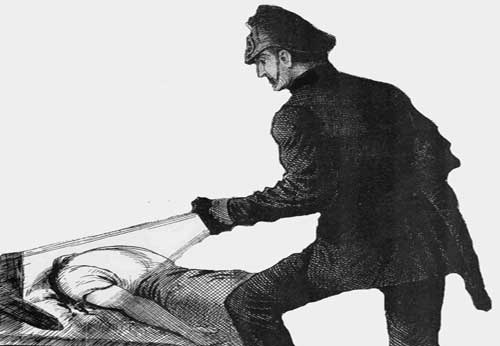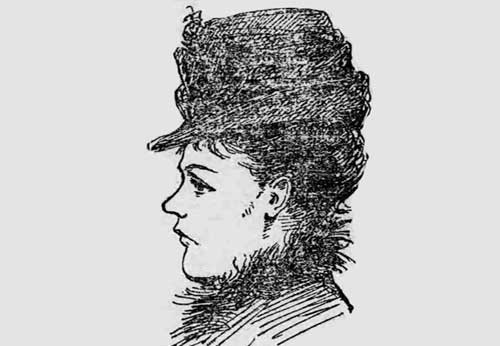- Although Martha Tabram's murder didn't generate the huge amount of newspaper coverage that was generated by the later murders, her killing certainly shocked people.
- Reading the various newspaper reports, it becomes apparent that journalists struggled to comprehend such a brutal and, seemingly, motiveless murder.
- People could not realise that this was merely the start of a shocking series of similar crimes.
- Site Author and Publisher Richard Jones
- Richard Jones
THE MARTHA TABRAM NEWSPAPER ARCHIVE
THE MURDER OF MARTHA TURNER
The murder of Martha Tabram (or Turner) murder took place in the early hours of the morning on the 7th August 1888.
As the newspapers began to report on what they, naturally, perceived as a truly horrific crime, it is noticeable that the various reporters are at a loss to explain how somebody could carry out such a violent and senseless murder. Indeed, you can almost sense their frustration as they struggle to find a motive.
It is with this murder that we also start to get an impression of the sheer horror being felt by the people living in the neighbourhood as they begin to react to the fact that something decidedly untoward is occurring in Whitechapel.
Of course, there is great debate as to whether or not Martha was a victim of Jack the Ripper.
You can decide for yourself as you read through the newspaper coverage that was given to her death.
A WHITECHAPEL HORROR
SOURCE: THE STAR
DATE: TUESDAY 7TH AUGUST 1888A woman, now lying unidentified at the mortuary, Whitechapel, was ferociously stabbed to death this morning, between two and four o'clock, on the landing of a stone staircase in George's-buildings, Whitechapel.
George's-buildings are tenements occupied by the poor laboring class.
A lodger going early to his work found the body.
Another lodger says the murder was not committed when he returned home about two o'clock.
The woman was stabbed in 20 places. No weapon was found near her, and her murderer has left no trace. She is of middle age and height, has black hair and a large, round face, and apparently belonged to the lowest class.
THE SUPPOSED MURDER IN WHITECHAPEL
SOURCE: THE MORNING POST
DATE: WEDNESDAY 8TH AUGUST 1888Early yesterday morning a man named Reeves, living at 37, George-yard buildings, Whitechapel, was coming down stairs to go to work, when he discovered the body of a woman lying in a pool of blood on the first-floor landing.
Reeves at once called in Constable Barrett, and Dr. Keeling, of Brick-lane, made an examination of the woman, and pronounced life extinct, giving it as his opinion that she had been brutally murdered, there being knife wounds on her breast, stomach, and abdomen.
The woman was, apparently between 35 and 40 years of age, about 5ft. 3in. in height, complexion and hair dark, wore a dark green skirt, a brown petticoat, a long black jacket, and a black bonnet.
The body has been removed to Whitechapel mortuary, and Inspector Reid, of the Criminal investigation Department, is making enquiries.
TRAGEDY IN WHITECHAPEL
WOMAN STABBED IN 39 PLACESSOURCE: LLOYD'S WEEKLY NEWSPAPER
DATE: SUNDAY 12TH AUGUST 1888About 10 minutes to five o'clock on Tuesday morning a man, who lives at 47, George-yard buildings, Whitechapel, was coming downstairs to go to work, when he discovered the body of a worm lying in a pool of blood on the first-floor landing.
Reeves at once called in Constable Barrett, 26, who was on his beat in the vicinity of George-yard and Dr. Keleene, of Brick-lane, was communicated with and promptly arrived.
He made an examination of the woman, and pronounced life extinct giving it as his opinion that she had been brutally murdered, there being knife wounds on her breast stomach, and abdomen. There were 39 wounds in various parts of the body, which was that of a woman apparently between 35 and 40 years of age, about 5ft. 3in. in height, complexion and hair dark; with a dark green skirt, a brown petticoat, a long black jacket, and a black bonnet.
The woman was not known to any of the occupants of the tenements on the landing on which the deceased was found, and no disturbance of any kind was heard during the night.
The body was removed to Whitechapel mortuary.
Mr. George Collier opened an inquest on the body on Thursday at the Working Lads' institute, Whitechapel.
She was stated to be Martha Turner, age 38, a single woman, lately living at 4, Star-place, Commercial-road, but previous to calling the first witness the coroner said that the body had been identified that morning, but he had just been informed that two other persons also identified it as quite a different person, and under these circumstances I thought the question of identity had better be left till the last.
Elizabeth Mahony, of 47, George-yard-building Whitechapel, the wife of a carman, stated that on the night of the Bank holiday she was out with some friends.
She returned shortly before two in the morning with her husband, and afterwards left the house to try and get some supper at the chandler's shop.
The stairs were then perfectly clear of any obstacle, an were the same on her return. She and her husband heard no noise during the night, but at 10 o'clock she was told that a murder had been committed in the building. There was no light on the staircase. The spot where the body was found had been pointed out to her. She was sure it was not there at two o'clock as she went in, as it was in the wide part of the stairs, and quite in the dark.
Alfred George Crow, a cabdriver, of 35, George yard-buildings, deposed that on Tuesday morning he returned home from work at half-past three. On his way up the stairs he saw somebody lying on the first landing. It was not an unusual thing to see, so he passed on and went to bed. He did not know whether the person was dead or alive when he passed.
John Saunders Reeves, 37, George-yard-buildings a waterside labourer, deposed that on Tuesday morning he left home at five o'clock to go in search of work. On the first floor landing he saw a female lying in a pool of blood. She lay on her back, and seemed dead.
He at once gave notice to the police.
The woman was a perfect stranger to the witness Her clothes were all disarranged, as if she had had a struggle with some one. The witness did not notice any instrument lying about.
Police-constable Barrett, 226 H, deposed to being called by the last witness to view the body of the deceased. She was lying on her back, and before she was moved a doctor was sent for, and on arrival he pronounced life extinct.
The woman's hands were clenched, but did not contain anything. Her clothes were disarranged.
Dr. Timothy Robert Keleene, 28, Brick-lane, stated that he was called to the deceased and found her dead. He examined the body and found 39 punctured wounds. There were no less than nine in the throat and 17 in the breast. She appeared to have been dead three hours. The body was well a nourished. He had since made a post-mortem examination, and found the left lung penetrated in five places, and the right lung in two places. The heart had been penetrated, but only in one place, others wise it was quite healthy. The liver was healthy, but penetrated in five places, and the spleen was a penetrated in two places. The stomach was penetrated in six places.
In the witness's opinion the wounds were not inflicted with the same instrument, there being a deep wound in the breast from some long, strong instrument, while most of the others were done apparently with a penknife. The large wound could have been caused by a sword bayonet or dagger.
It was impossible for the whole of the wounds to be self-inflicted. Death was due to the loss of blood consequent on the injuries.
At the conclusion of this witness's evidence the inquiry was adjourned.
TWO ARRESTS AT THE TOWER
The case is in certain respects one of a very puzzling character, owing to the fact that so many stab wounds were inflicted, and that no cries were heard, although the poor woman was on some stone steps, close to the doors of small rooms wherein several separate families resided.
It now appears that on the night of Bank holiday there were several soldiers in the neighbourhood, some of whom were seen drinking in the Princess Alice - two minutes walk from George-yard-buildings - and other taverns near.
With these soldiers were the deceased and another woman, the latter being known in the district as "Mogg" and "Pearly Poll." One of these men was a private, the other a corporal. It has been ascertained that only corporals and sergeants are allowed to wear side arms when on leave. This fact, of course, narrows the issue as to the possible identity of the assailant - presuming he was a soldier.
Inquiries were at once set on foot by the police and military authorities, with the result that it is stated two soldiers have been placed under military arrest at the Tower. The authorities decline to give their names unless some definite charge is formulated. The two soldiers are said to belong to the Guards.
A perplexing feature in connection with the outrage is the number of injuries on the young woman's body. That the stabs were from a weapon shaped like a bayonet is almost established beyond doubt. The wound over the heart was alone sufficient to kill, and death must have occurred as soon as that was inflicted.
Unless the perpetrator was a madman or suffering to an unusual extent from drink delirium, no tangible explanation can he given of the reason for inflicting the other 38 injuries, some which almost seem as if they were due to thrusts and cuts from a penknife.
On the other hand, if the lesser wounds were given before the one fatal injury the cries of the deceased must have been heard by those who, at the time of the outrage, were sleeping within a few yards of the spot where the deed was committed.
The difficulty of identification arose out of the brutal treatment to which the deceased was manifestly subjected, she being throttled while held down and the face and head so swollen and distorted in consequence that her real features are not discernable.
There is little doubt, although she has been variously identified as a Mrs. Withers, and Mary Bryan, that she is a woman known as Martha Turner.
Mrs. Bousfield, in whose house she lived till three weeks back, states that she had resided in her house for two months with Turner. The deceased had told her that her real name was either Staples or Stapleton. and that she had left her husband 13 years, and had taken up with Turner.
Both she and this man got their living by selling trinkets in the streets, such as studs, link chains, and menthal cones. She used to stand in Cheapside and various places, whilst Turner occupied other ground.
Turner left her some few weeks ago, and then the deceased, who paid 2s. per week for her room, got two weeks in arrears, and as she could not pay she suddenly left.
In addition to being identified by Mrs. Bousfield, the deceased has already been identified by one or to other women, who saw her in the company of some soldiers at neighbouring public-houses. There was a dispute, and one of the soldiers struck the companion of the deceased a blow. This was just by Georg yard, a long, dark thoroughfare, and it is believed that the deceased was forcibly dragged up to the place where she was found so brutally ill-treated and so fearfully wounded.
The police have a description of the two soldiers who, as before stated, are believed to be in the Guards.
THE WHITECHAPEL MURDER
THE MORNING ADVERTISER
DATE: THURSDAY 16TH AUGUST 1888At noon yesterday there was a parade of Coldstream and Grenadier Guards at the Wellington Barracks, Pimlico, for the purpose of the possible identification of one or more of the men on a charge of murder.
Soon after eleven o'clock two police-officers - Inspector Reid and Detective-sergeant Caunter - arrived with Mary Ann Conolly (otherwise "Pearly Poll") and requested permission to make inquiries with regard to the murder of Martha Turner at Whitechapel on the night of Bank Holiday.
The "assembly" call was at once sounded, and the men were drawn up in quarter-column, after which they filed through a passage, where Inspector Reid, Sergeant Caunter, and another police-officer were stationed with "Pearly Poll."
The woman was asked to scrutinize the faces of the soldiers as they passed, for the purpose of seeing if she could pick out either of the men who were with her and the deceased on the night on which the murder was committed.
After a small number had filed past "Pearly Poll" picked out a man wearing stripes, and taken by her to be a corporal, as the one who went away with the deceased woman.
"That's him," exclaimed she; "I'm positive."
The suspect was temporarily detained, and the filing by of the others continued.
When a few more had passed, the woman, scanning the features of every one intently, pointed to a private as being the second man. She positively declared that he accompanied her to a house in the district where the murder took place.
"Are you positive?" [Poll] was asked, and "Pearly Poll" nodded, and replied, "Certain."
The military authorities immediately placed all the books, showing the time at which the suspected men left and returned to the barracks on the night mentioned, at the disposal of Inspector Reid and Sergeant Caunter.
It was pointed out that the "corporal" was but a private with good conduct stripes, a man of exemplary character, who was in the barracks by ten o'clock on Bank Holiday night.
Other evidence as to his innocence, and also respecting the private's movements on the night of the crime, was also forthcoming.
The former man was at once exonerated, while the second, also a man of exceptionally good character, was formally told that further inquiries must be instituted. These inquiries were duly conducted, and he, too, was told that no stain rested upon him, as it was clearly a case of mistaken identity.
It is asserted that, as "Pearly Poll" has "identified" two innocent men, who could not have been in Whitechapel at the time she said, the police will not further seek her aid in elucidating the mystery.
Neither of the men worse side-arms when they left the barracks on Bank Holiday, and could not possibly have been in each other's company.
The authorities say that they must now look elsewhere for a clue.
THE WHITECHAPEL MURDER
INQUEST AND VERDICTSOURCE: LLOYD'S WEEKLY NEWSPAPER
DATE: SUNDAY 26TH AUGUST 1888Mr Collier resumed the inquiry at the Working Lads' Institute, Whitechapel, Thursday, into the circumstances attending the death of a woman who passed by the name of Martha Turner, aged 35, a hawker lately living at 4, Star-place, Star-street, Commercial-road East, who was discovered early on the morning of Tuesday, the 7 inst.. lying dead on the first-floor landing of some model dwellings known as George yard-buildings, Commercial-street, Spitalfields.
The woman when found presented a shocking appearance, her body being covered with 39 stab wounds, some of which had been done with a bayonet.
How the woman came to be in these dwellings is a mystery which the police as yet have not solved.
The affair caused great excitement and much interest was manifested in the proceedings.
It is worthy of mention that the murder was committed on Bank holiday night, and is almost identical with another murder which was perpetrated near the same spot on the night of the previous Bank holiday.
The victim in each case was a poor unfortunate, and their cowardly assailants have up till now evaded capture.
Mr. Henry Samuel Tabran, of 6, River terrace, East Greenwich, stated that he was a foreman packer in a furniture warehouse.
He identified the body of the woman now dead as his wife.
Her name was Martha Tabran, and she was 39 years of age.
He last saw her alive 18 months ago in the Whitechapel-road. Witness had been separated from her 13 years. He went before Mr. Benson, the magistrate, and said he should not live with her on account of her intemperate habits. She took out a warrant for his arrest for desertion, but he agreed to allow her 12s. a week. This was carried on for three years, but afterwards finding how she was living he only gave her 8s. 6d. a week.
She was at that time living with another man.
Henry Turner, who stated that he lived at the Working Men's home, Commercial-street, deposed that he was a carpenter by trade, but latterly he had got his living as hawker.
Up till three weeks previous to this affair he was living with the deceased. They had lived together on and off for nine years.
He last saw her alive on the Saturday before her death, when they met accidentally in Leadenhal!-street.
Witness first heard of her death on the day of the inquest.
On the Saturday when he saw her she said she had got no money, so witness gave her some to buy stock with.
Deceased was a woman who, when she had the money, would get drunk with it. She was in the habit of staying out late at night, but witness did not know what for.
He was not aware that she was acquainted with "Pearly Poll."
They lived comfortable until she took to drink, when he left her for a time. He never quarreled with her, but simply left her.
Mary Bousfield. 4, Star-place, Commercial-road, deposed that Turner and the deceased lived at her house till three weeks before her death. She was a woman who would rather have a glass of ale than a cup of tea; but she did not get drunk.
Witness said that Turner was very good to her, and had helped to support two children she had by her husband.
Deceased was greatly in witness's debt, and left without giving notice.
Since then she had returned and forced the window, and occupied the room one night without witness knowing she was there.
Ann Morris. 23, Lisbourne-street, E., a widow, deposed that she was the sister-in law of the deceased.
Witness last saw her alive on Bank holiday, as she was entering the White Swan public-house in Whitechapel-road. Deceased then appeared to be sober. She was alone when she entered the bar. Witness did not know if any soldiers were in the public-house.
Deceased had been charged several times for annoying witness and breaking the windows of her house. She fancied that witness was encouraging her brother (the deceased's husband) to live there.
Mary Ann Connelly ("Pearly Poll") was next called, but Inspector Reid asked that she might be cautioned previous to being sworn. This the coroner did, and she said that she had been lodging at a lodging house in Dorset-street. She was a single woman, and gained her livelihood on the streets.
She had known the deceased for four or five months under the name of "Emma."
The last time she saw her alive was on Bank holiday, at the corner of George-yard, Whitechapel. They went to a public-house together, and parted about 11.45. They were accompanied by two soldiers, one a private and the other a corporal. She did not know to what regiment they belonged, but they had white bands round their caps. Witness did not know if the corporal had any side arms.
They picked up with the soldiers together, and entered several public-houses, where then drank.
When they separated the deceased went away with the private. They went up George-yard, while witness and the corporal went up Angel-alley.
Before they parted witness and the corporal had a quarrel, and he hit her with a stick. She did not hear deceased have any quarrel.
Witness never saw the deceased again alive.
By the Coroner: Deceased was a woman who did not drink much.
Witness had tried to identify the two men, and at one of the barracks, where the men were paraded before her, she picked out two men who she thought were the same that were with her and the deceased on the night of the murder That was at Wellington barracks. She had never seen the men before.
By Mr. Reid: Witness left the corporal at the corner of George-yard about five or 10 minutes past 12, and afterwards went along Commercial-street, towards Whitechapel. She heard no screams, and was first informed of the murder on the Tuesday.
Inspector Reid: Did you threaten drown yourself since this occurrence?
Witness: Yes; but only in a "lark." I went to my cousin's, and stayed there two days. My cousin lives in Fuller's-court, Drury-lane.
Inspector Reid said that the witness kept out of the way purposely, and it Was only by searching that they found her.
By the Jury: Neither witness nor deceased was sober when they parted on Bank holiday night, but they were not drunk. Altogether they were drinking one hour and three-quarters.
Detective-inspector Reid informed the court that many persons had come forward and made statements which, when threshed out, ended unsatisfactorily, and up to the present the police had been unable to secure the guilty party or parties.
The coroner, in summing up, said he was bound to acknowledge that the military authorities had rendered every possible assistance.
He was sorry for several reasons that the perpetrator of this crime, which was one of the most horrible crimes that had been committed for some time past - the details being so horrible that there was a refinement of brutality about some parts of it which was nothing less than fiendish - had not been traced.
After a few minutes' consultation the jury returned a verdict to the effect that the murder was committed by some person persons unknown: and added a rider, which they stated their opinion that the staircases of these model dwellings, which existed all over London, should be lighted up at night.

